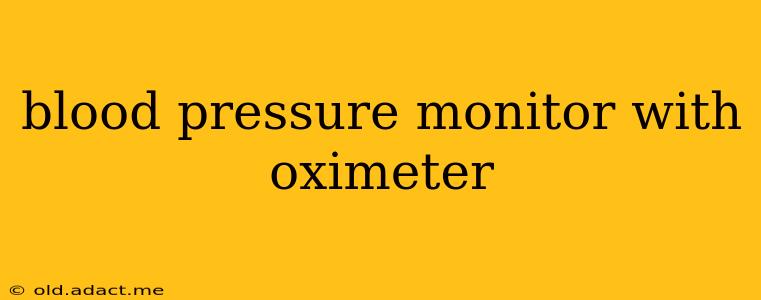Monitoring your blood pressure and oxygen saturation levels is crucial for maintaining overall health. A combined blood pressure monitor with oximeter offers a convenient and efficient way to track these vital signs from the comfort of your home. This comprehensive guide explores the benefits, features, and considerations when choosing a blood pressure monitor with an integrated oximeter.
What is a Blood Pressure Monitor with Oximeter?
A blood pressure monitor with oximeter combines two essential health monitoring devices into one. It measures your blood pressure (systolic and diastolic readings) and your blood oxygen saturation (SpO2), often displaying the pulse rate as well. This dual functionality makes it a valuable tool for individuals with heart conditions, respiratory issues, or those simply wanting to proactively manage their health.
Why Choose a Blood Pressure Monitor with Oximeter?
The convenience of having both measurements in one device is a significant advantage. Regular monitoring of both blood pressure and oxygen saturation can help:
- Early Detection of Health Issues: Changes in blood pressure and SpO2 levels can signal underlying health problems such as heart failure, lung disease, or sleep apnea. Early detection allows for timely intervention and treatment.
- Improved Health Management: Regular monitoring empowers individuals to actively manage their health, making informed decisions about lifestyle changes and medication.
- Peace of Mind: For individuals with pre-existing conditions, having access to these vital readings provides peace of mind and a sense of control.
- Comprehensive Health Data: Tracking both metrics provides a more holistic picture of your overall health, enabling you to identify potential correlations and discuss them with your healthcare provider.
What Features Should I Look for in a Blood Pressure Monitor with Oximeter?
Choosing the right device requires consideration of several factors:
- Accuracy and Reliability: Look for monitors with clinically validated accuracy, often indicated by certifications or approvals from regulatory bodies.
- Ease of Use: The device should be easy to operate, with clear instructions and a user-friendly interface. Large displays and intuitive button layouts are essential, especially for older adults.
- Data Storage and Recall: The ability to store and recall past readings allows for trend analysis and sharing information with healthcare providers.
- Connectivity: Some models offer Bluetooth connectivity, enabling you to sync readings with a smartphone app for easier tracking and data management. Consider whether this feature is important to you.
- Portability: If you plan to use the monitor on the go, portability is a key consideration. Look for compact and lightweight designs.
- Warranty and Customer Support: Choose a reputable brand with a solid warranty and responsive customer support.
How Accurate Are Blood Pressure Monitors with Oximeters?
The accuracy of blood pressure monitors with oximeters varies depending on the brand, model, and individual factors. Always follow the manufacturer's instructions for proper use to obtain the most accurate readings. It's crucial to remember that home monitoring devices provide an indication of your health, but they shouldn't replace regular checkups with a healthcare professional.
What is the Difference Between a Blood Pressure Monitor and a Pulse Oximeter?
A blood pressure monitor measures the pressure of your blood against the artery walls, providing systolic and diastolic readings. A pulse oximeter measures the oxygen saturation level in your blood (SpO2) and pulse rate. While both devices monitor vital signs, they measure different aspects of your health. A combined unit provides both readings simultaneously.
Can I Use a Blood Pressure Monitor with Oximeter to Diagnose Medical Conditions?
No. A blood pressure monitor with oximeter is a screening tool, not a diagnostic device. While it can provide valuable data, it should not be used to self-diagnose or treat any medical conditions. Always consult your physician for diagnosis and treatment of any health concerns.
How Often Should I Use a Blood Pressure Monitor with Oximeter?
The frequency of use depends on your individual health needs and your doctor's recommendations. Your healthcare provider can advise you on the appropriate monitoring schedule based on your specific health conditions and risk factors.
Where Can I Buy a Blood Pressure Monitor with Oximeter?
Blood pressure monitors with oximeters are widely available online and in pharmacies, medical supply stores, and some retail stores. Comparing prices and features from different brands and retailers is recommended.
This information is for educational purposes only and does not constitute medical advice. Always consult your healthcare provider for any health concerns or before making any decisions related to your health or treatment.
